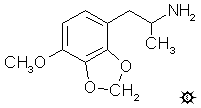
#135 MMDA-3b
4-METHOXY-2,3-METHYLENEDIOXYAMPHETAMINE
|
| [3D .mol structure] |
A suspension of 7.0 g LAH in 1 L anhydrous Et2O under an inert atmosphere was brought to a gentle reflux. The reflux condensate was passed through a Soxhlet thimble containing 6.15 g 1-(4-methoxy-2,3-methylenedioxyphenyl)-2-nitropropene which was effectively adding the nitropropene as a saturated solution. The mixture was maintained at reflux for 16 h. After cooling to 0 °C with an ice bath, the excess hydride was destroyed by the addition of 800 mL of 1.5 N H2SO4. The phases were separated, and the aqueous phase washed with 2x100 mL Et2O. To this phase there was added 175 g potassium sodium tartrate followed by sufficient 25% NaOH to raise the pH >9. This was then extracted with 3x100 mL CH2Cl2, and the solvent from the pooled extracts removed under vacuum. The residual off-white oil weighed 5.4 g and was dissolved in 250 mL anhydrous Et2O and saturated with anhydrous HCl gas. There was produced a crop of slightly sticky white solids that finally became granular and loose. These were removed by filtration, washed with Et2O, and air dried to give 5.56 g of 4-methoxy-2,3-methylenedioxyamphetamine hydrochloride (MMDA-3b) with a mp of 196-199 °C. A small sample from propanol had a mp of 199-200 °C, and a sample from nitromethane/MeOH (5:1) had a mp of 201-202 °C.
DOSAGE: greater than 80 mg.
DURATION: unknown.
QUALITATIVE COMMENTS: (with 60 mg) Definitely active. Qualitatively like MDA; quantitatively perhaps less.
(with 80 mg) No more effective than 60 mg.
EXTENSIONS AND COMMENTARY: And that's all there is known as to the activity of MMDA-3b in man. Very, very little. Nothing has ever been tried in excess of 80 milligrams that I know of, and the above trials were made over 20 years ago. There can be little argument that the 3b is less effective than the 3a, but no one can say by how much. The literature statement is that it is threefold less, but that was based on the relative responses at just-above-threshold levels. The effects here are hand-wavingly similar to those reported for MMDA-3a at 20 milligrams, but these are difficult to compare accurately as they were reported by different people. There have been absolutely no animal studies reported with MMDA-3b in the scientific literature. And neither the 2-carbon nor the 4-carbon analogues of MMDA-3b has even been prepared.
The remaining MMDA-analogue that has been prepared, is the 2,3,6-isomer. The flow diagram started with sesamol (3,4-methylenedioxyphenol) which was methylated with methyl iodide, converted to the aldehyde using butyllithium and N-methylformanilide (putting the new group directly between the two oxygen atoms, giving 2,3-methylenedioxy-6-methoxybenzaldehyde), reaction with nitroethane to the nitrostyrene, and its reduction with lithium aluminum hydride in ether. The product, 6-methoxy-2,3-methylenedioxyamphetamine hydrochloride (MMDA-5) is practically unexplored in man. I have heard one report that 30 milligrams was modestly active, but not a particularly pleasant experience. Another person told me that he had tried 15 milligrams, but he neglected to mention if there had been any effects. I have not tried it myself. But, I have succumbed to the pressure of the experimental pharmacologists to give a number for the "Y-axis" of their animal behavior studies. So I said to myself, if this is active at 30 milligrams, and mescaline is active at 300 milligrams, why not say that it is 10x the activity of mescaline? So I did. But I have absolutely no confidence in that number.
And if the information on MMDA-5 is sparse, look at the positional isomer, MMDA-4, which I have discussed under its analogue TMA-4. Here nothing is known at all, since the compound itself is unknown. No one has yet found a way of making it.
| [ |
[Main Index] | [Forward |

